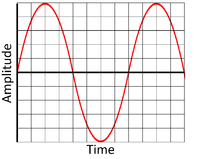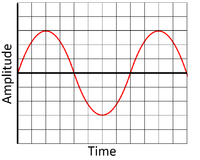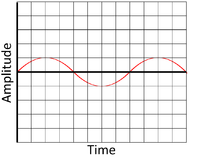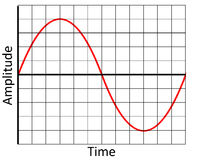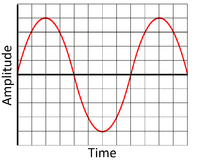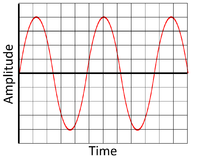Difference between revisions of "Oscilloscope"
| Line 53: | Line 53: | ||
| style="height:20px; width:200px; text-align:center;" |This is a high [[frequency]] [[wave]] on an [[oscilloscope]] screen. | | style="height:20px; width:200px; text-align:center;" |This is a high [[frequency]] [[wave]] on an [[oscilloscope]] screen. | ||
|} | |} | ||
| + | |||
| + | ===References=== | ||
| + | ====AQA==== | ||
| + | |||
| + | :[https://www.amazon.co.uk/gp/product/178294558X/ref=as_li_tl?ie=UTF8&camp=1634&creative=6738&creativeASIN=178294558X&linkCode=as2&tag=nrjc-21&linkId=f0dfb66dafcb0c6e9449e7b1a4ae1ac351 ''Oscilloscopes (generated potential difference), page 97, GCSE Physics; The Revision Guide, CGP, AQA ''] | ||
| + | :[https://www.amazon.co.uk/gp/product/1782945598/ref=as_li_tl?ie=UTF8&camp=1634&creative=6738&creativeASIN=1782945598&linkCode=as2&tag=nrjc-21&linkId=ad276ad49df77ab4b40ab4fd0fe10127 ''Oscilloscopes, page 220, GCSE Combined Science; The Revision Guide, CGP, AQA ''] | ||
| + | :[https://www.amazon.co.uk/gp/product/1782946403/ref=as_li_tl?ie=UTF8&camp=1634&creative=6738&creativeASIN=1782946403&linkCode=as2&tag=nrjc-21&linkId=32a0abb60dff015b15b50e9b1d7b4644 ''Oscilloscopes, pages 192, 203, 236, GCSE Combined Science Trilogy; Physics, CGP, AQA ''] | ||
| + | :[https://www.amazon.co.uk/gp/product/1782945970/ref=as_li_tl?ie=UTF8&camp=1634&creative=6738&creativeASIN=1782945970&linkCode=as2&tag=nrjc-21&linkId=a120d24dcc7cc7a58192069a3aafc1d2 ''Oscilloscopes, pages 227-229, 245, 304, 305, 332, GCSE Physics; The Complete 9-1 Course for AQA, CGP, AQA ''] | ||
| + | :[https://www.amazon.co.uk/gp/product/019835939X/ref=as_li_tl?ie=UTF8&camp=1634&creative=6738&creativeASIN=019835939X&linkCode=as2&tag=nrjc-21&linkId=57e96876985fc39b1a3d8a3e3dc238b6 ''Oscilloscopes, pages 65, 184-185, GCSE Physics; Third Edition, Oxford University Press, AQA ''] | ||
Revision as of 15:39, 10 November 2019
Contents
Key Stage 3
Meaning

A picture of an oscilloscope.
An oscilloscope is a measuring instrument used to measure the frequency and amplitude of oscillations.
About Oscilloscopes
- Oscilloscopes display the information on a screen with the amplitude on the y-axis and time on the x-axis.
| This is a high amplitude wave on an oscilloscope screen. | This is a low amplitude wave on an oscilloscope screen. |
| This is a low frequency wave on an oscilloscope screen. | This is a high frequency wave on an oscilloscope screen. |
Key Stage 4
Meaning
An oscilloscope is a measuring instrument used to measure the frequency and amplitude of oscillations.
About Oscilloscopes
- Oscilloscopes display the information on a screen with the amplitude on the y-axis and time on the x-axis.
| This is a high amplitude wave on an oscilloscope screen. | This is a low amplitude wave on an oscilloscope screen. |
| This is a low frequency wave on an oscilloscope screen. | This is a high frequency wave on an oscilloscope screen. |
References
AQA
- Oscilloscopes (generated potential difference), page 97, GCSE Physics; The Revision Guide, CGP, AQA
- Oscilloscopes, page 220, GCSE Combined Science; The Revision Guide, CGP, AQA
- Oscilloscopes, pages 192, 203, 236, GCSE Combined Science Trilogy; Physics, CGP, AQA
- Oscilloscopes, pages 227-229, 245, 304, 305, 332, GCSE Physics; The Complete 9-1 Course for AQA, CGP, AQA
- Oscilloscopes, pages 65, 184-185, GCSE Physics; Third Edition, Oxford University Press, AQA
